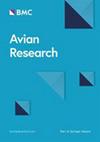Avian hippocampus: Recent advances in anatomy and physiological functions
IF 1.6
2区 生物学
Q1 ORNITHOLOGY
引用次数: 0
Abstract
The avian hippocampus, akin to its mammalian counterpart, plays a critical role in cognitive and physiological processes despite notable structural differences. Initially thought to be less developed, recent studies over the past two decades have revealed it as a complex brain region essential for diverse functions in both laboratory and free-living birds. This review synthesizes current knowledge on the avian hippocampus' organization, functionality, and neurophysiological significance. We first examine its anatomical structure and neuronal connectivity, comparing it with the mammalian hippocampus. We then highlight how its volume, neuronal density, and neurogenesis support spatial memory and navigation, influencing behaviors such as migration, food storing, brood parasitism, and homing. Beyond spatial functions, the avian hippocampus mediates emotion and stress physiology through interactions with the endocrine system, particularly via glucocorticoid receptors. It also influences spatial memory through sex hormones, especially estradiol, with local estrogen production through aromatase activity enhancing memory and plasticity. Therefore, the avian hippocampus serves as a central neural hub, integrating sensory information with internal states to facilitate essential behaviors and responses to external environmental stimuli. This review underscores the progress made in understanding this brain structure's roles, highlighting conserved neurophysiological functions across vertebrate taxa.
鸟类海马:解剖学和生理功能方面的最新进展
鸟类的海马区与哺乳动物的海马区相似,尽管在结构上有显著差异,但在认知和生理过程中发挥着关键作用。最初,人们认为鸟类海马的发育程度较低,但过去二十年的最新研究表明,无论是在实验室还是在自由生活的鸟类中,海马都是一个复杂的脑区,对鸟类的多种功能至关重要。本综述综合了目前有关鸟类海马组织、功能和神经生理学意义的知识。我们首先研究其解剖结构和神经元连接,并将其与哺乳动物的海马进行比较。然后,我们重点介绍了海马的体积、神经元密度和神经发生如何支持空间记忆和导航,影响迁徙、食物储存、雏鸟寄生和归巢等行为。除了空间功能外,鸟类海马还通过与内分泌系统的相互作用,特别是通过糖皮质激素受体,介导情绪和应激生理。它还通过性激素(尤其是雌二醇)影响空间记忆,通过芳香化酶活性产生的局部雌激素可增强记忆和可塑性。因此,鸟类海马是一个中枢神经枢纽,它将感官信息与内部状态整合在一起,以促进基本行为和对外部环境刺激的反应。这篇综述强调了在了解这种大脑结构的作用方面所取得的进展,突出了脊椎动物类群之间神经生理功能的一致性。
本文章由计算机程序翻译,如有差异,请以英文原文为准。
求助全文
约1分钟内获得全文
求助全文
来源期刊

Avian Research
ORNITHOLOGY-
CiteScore
2.90
自引率
16.70%
发文量
456
审稿时长
46 days
期刊介绍:
Avian Research is an open access, peer-reviewed journal publishing high quality research and review articles on all aspects of ornithology from all over the world. It aims to report the latest and most significant progress in ornithology and to encourage exchange of ideas among international ornithologists. As an open access journal, Avian Research provides a unique opportunity to publish high quality contents that will be internationally accessible to any reader at no cost.
 求助内容:
求助内容: 应助结果提醒方式:
应助结果提醒方式:


